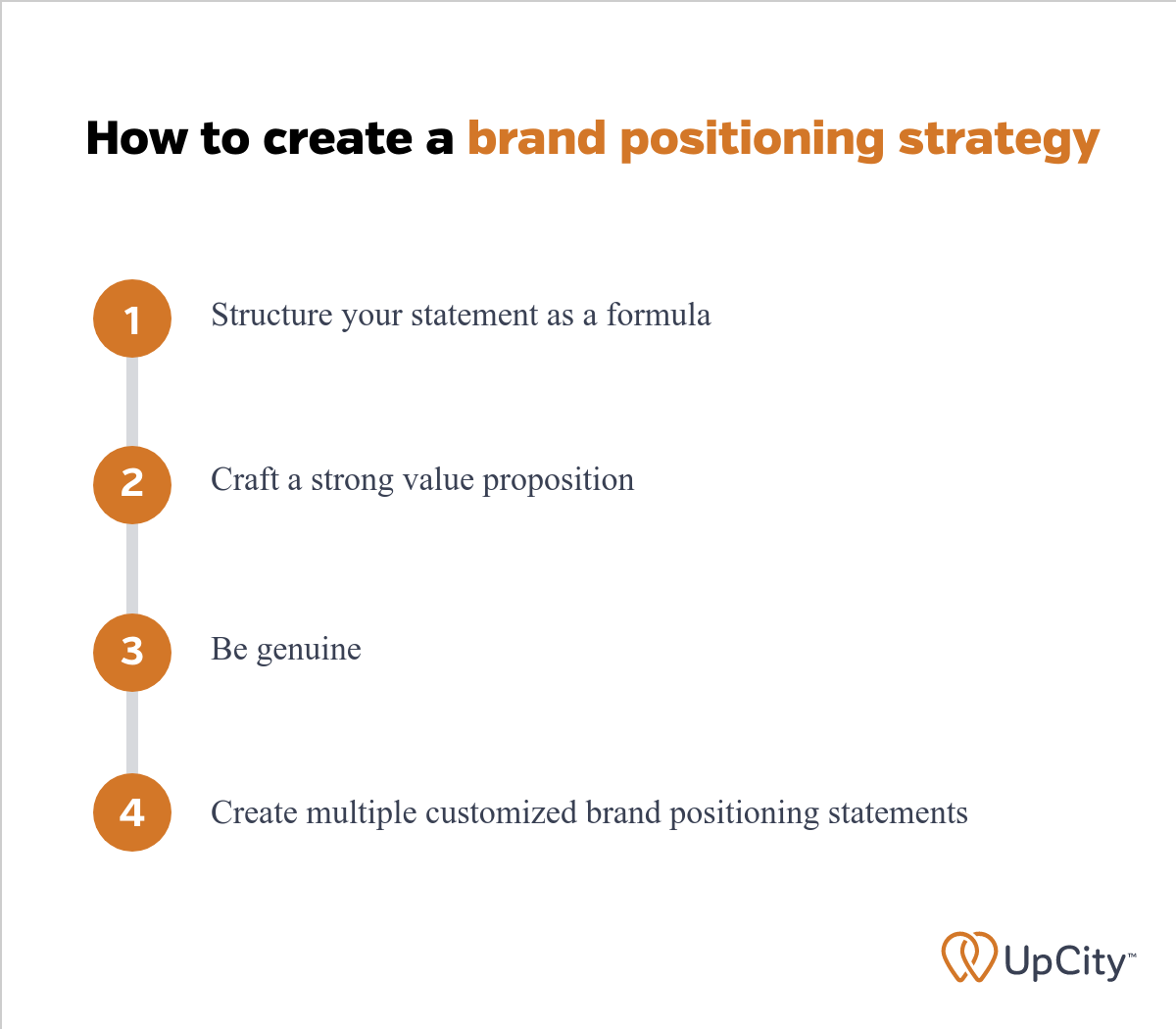Product differentiation is critical to a successful modern marketing strategy, especially for brands focused on product-led growth. It helps brands establish a competitive advantage within their industries. However, business leaders, brand managers, public relations, and marketing experts often need help executing product differentiation effectively.
One strategy to enhance brand perception is to convey brand ideology, including its values, principles, and priorities, and establish a competitive advantage. Stakeholders can accomplish this goal by incorporating a brand positioning strategy built upon a foundational brand positioning statement with a strong value proposition. This strategy can allow involved experts to benefit from the resulting competitive advantage. But first, they must understand the intricacies of effectively crafting and leveraging a brand positioning statement.
What is a brand positioning statement?

A brand positioning statement is an internal document that helps communicate your brand’s value proposition to existing and potential customers in your ideal target market. A small business’s marketing team can use the statement as a roadmap to guide ongoing and future marketing and communications campaigns, ensuring efficiency and success in lead acquisition, conversion, and customer retention.
What is the goal of brand positioning?
Your brand positioning statement should be less of a mission statement or a vision statement, as these lay the foundation for your brand and provide the path forward for your employees. Instead, it should outline a unique brand identity for your company. Effective brand positioning statements are built around three primary components.
- Identify your business’s target audience for the current brand initiative and convey the problem your products should solve for that audience.
- Assess your competitors and their methods to meet your target audience’s needs.
- Outline how your product or services can more effectively fulfill those needs than your competitors while adding value to the relationship.
In focusing on these three components, your brand positioning statement allows your marketing team to accomplish several key objectives.
Establish realistic expectations of ROI for brand investments
Small business leaders often don’t have a clear understanding of how brand marketing can impact their business. According to a recent Gartner brand management analysis, “3 Steps to Align Corporate and Product Brand Positioning,” over 60% of brand leaders share that their senior-most enterprise leaders have unrealistic expectations for the impact of brand investments. [1]
An effective brand positioning statement outlines the anticipated improvements to lead generation and conversions that can be expected from leveraging the brand’s unique value proposition.
Resonate with new generations
While price and value-sensitive in their consumer habits, millennials, Generation Z, and future generations are increasingly concerned with the values and beliefs a brand portrays through marketing. This stance is so strong that 38% of millennials and 40% of Generation Z consumers will only buy from brands that accurately reflect their values and beliefs. [2] A strong brand positioning statement provides younger consumers with the clarity and transparency they seek in advertising and branding to understand what’s truly being offered by a company.
Identify the most effective methods to position your brand for success
Brand positioning isn’t a passive marketing exercise where a business can sit back and rely on the combination of a logo and a tagline to differentiate their products and services from competitors. Positioning tactics are built around marketing tactics such as brand reputation management to actively improve the opportunities for your brand to engage with consumers.

Brand positioning statements are integral to your business’s online brand reputation management efforts. Twenty-one percent of businesses polled in an UpCity survey say that a primary goal of online brand reputation management should be to establish a dialogue with your target audience and, throughout the campaign, discover opportunities to develop and position your brand more effectively against the competition.*
Legacy brand updates and brand consolidation
Branding must adapt to the evolution of the business over time. In Gartner’s 2023 Tech Marketing Organizational Design Survey, 42% of respondents increased their investment in brand positioning to update the legacy brand image that no longer reflected the company. Thirty-two percent of respondents pointed to a consolidation of multiple brands due to mergers, purchases, or acquisitions as a driving factor in investing in branding. [3]
A brand positioning statement can lay the foundation for and reveal the path ahead when revitalizing a legacy brand or updating branding to reflect a pivot in the business model or vision. Similarly, when multiple brands are consolidated under a single brand banner, a brand positioning statement can help existing and potential customers see the value in remaining with the products or services they have come to rely upon while embracing the new possibilities being introduced in the consolidation.
How to create a brand positioning strategy
Crafting a brand positioning strategy requires you to answer five primary questions before getting started:
- Who is your target audience?
- What industry or market are you competing in?
- What problems do your products or services address and solve, and how do they do so?
- What’s the benefit of using your product or service as a solution versus staying with the competition?
- What evidence do you have to support your claim that your product or service is a better solution for your target market compared to competitors?

Structure your statement as a formula
Once you’ve written simple answers to the above questions, you’ll want to create a more formal brand positioning statement that incorporates your answers to each of those questions according to the following guide:
“In order to attract [target audience], our company’s team of experts must ensure that we deliver an experience like no other operating in the [industry]. Our brand delivers [unique points of differentiation], resulting in [benefits versus the competition], as proven by [evidence].”
Craft a strong value proposition
Your competitive advantage is at the core of your brand positioning strategy, and enumerating what sets your brand apart from the competition will allow you to weave those benefits clearly and concisely into your brand positioning statement.
Be genuine
Your positioning statement should align with your brand’s core values and the personality your company conveys to your target audience. If you’re a laid-back, casual company, your positioning statement should reflect that, just as you should take a more serious and professional tone in your brand positioning statement if your target audience expects that of you as a service provider.
Create multiple customized brand positioning statements
As a modern business owner, you might operate in multiple markets or provide services and products targeted to different audiences. Your approach to crafting brand positioning statements shouldn’t be a one-size-fits-all strategy; rather, you should plan to craft multiple statements, each catering to a different segment of your target audience or supporting the different product or service lines you’re maintaining.
Brand positioning strategies and examples
Your brand positioning statement should provide answers to the five primary questions outlined above, accomplishing several major goals:
- Highlight your core values.
- Connect with the target audience in a relevant way.
- Take a unique and targeted sales approach to your product or service.
- Use simple language to deliver your messaging in a concise and streamlined way.
To accomplish these goals, you can take several stances in your positioning statement, focusing on specific benefits based on your product or service.
- Price-based strategy to highlight your affordability and value.
- Quality-based strategy to highlight your products or services’ superiority to the competitors.
- Value-based strategy might downplay pricing and highlight product quality to attract customers willing to pay more to get a better experience than your competitors.
- Superior customer service strategy to highlight the positive experience your customers can anticipate receiving from your team.
- Convenience strategy to highlight how your product or service improves customers’ quality of life or removes complications from their existing routine.
Examples of brand positioning statements
To give small business owners an idea of what a brand positioning statement should look like on the page, we’ve listed some examples from popular brands based on statements gathered from around the web.
Amazon
“Amazon distinguishes itself from other online retailers with our passion for providing innovative solutions to the needs of customers who demand a high-quality experience. Amazon provides a one-stop shopping experience for online consumers looking to consolidate their shopping efforts by allowing them to purchase a wide range of products and providing an infrastructure that allows for a fast, streamlined delivery experience.”
Amazon’s brand positioning statement is direct and transparent as a leading online eCommerce platform. It helps consumers understand why the brand should be their first choice to simplify their shopping experience.
Nike
“At Nike, we are committed to investing in the latest technologies, allowing us to create innovative, high-quality, and top-performing sports apparel and footwear with the highest quality materials available. Our products are considered the most advanced in the athletic apparel industry and Nike is sought after by athletes in need of industry-leading and fashionable athletic wear.”
Nike has to navigate a delicate balance between positioning itself as a leading sportswear brand and providing products accessible to customers seeking high-quality footwear and activewear. The challenge is to appeal to athletes of all kinds while remaining inclusive of any consumer seeking Nike’s apparel.
Coca-Cola
“Coca-Cola provides a wide range of refreshing options for individuals seeking high-quality beverages. Each of our products is designed around ensuring we provide customers consuming Coca-Cola brand drinks with a positive experience. Unlike other beverage brands on the market, Coca-Cola is committed to inspiring happiness and ensuring we positively impact our customers’ lives, as we aspire to remain focused completely upon the needs and expectations of our consumers and customers.”
The Coca-Cola brand positioning stance is a perfect example of how this marketing tool can be leveraged to help focus attention not on the quality of the company’s products but on the customer experience with the brand. Coca-Cola assures consumers that the brand is more concerned with their needs than other brands. This statement caters to modern consumers who always aim to choose the best.
Pro tip: Devise an adaptable brand strategy that grows with the business. As per a Gartner survey, 41% of brand leaders have created or revised their brand’s positioning in the two years before the survey. [4] Reviewing your strategy in short intervals will also help you stay ahead of competitors.
How to leverage branding services
Brand management is a complex undertaking that only some small businesses might have the resources or staff expertise to tackle. You can connect with marketing agencies and freelancers focusing on brand management to elevate your brand positioning statement.
Maximize lead conversion and position your brand for success
Brand positioning is a powerful way to leverage your value proposition and increase brand visibility with your target audience in order to grow sales. Aside from a partnership with an agency or contractor specializing in brand management, your team can further educate themselves on best practices with these additional expert insights:
Sources
- Quick Answer: 3 Steps to Align Corporate and Product Brand Positioning, Gartner
- Create Effective Brand Positioning in a Volatile Environment, Gartner
- 5 Steps to Creating a Portfolio Brand Strategy to Shift Market Perceptions, Gartner
- Position Your Brand to Drive Preference and Purchase, Gartner
Methodology
*UpCity’s Role of AI in Digital Brand Management Survey was conducted online in October 2023 among 554 respondents in the U.K. (n=201) and Mexico (n=353). Respondents were screened for employment in their company’s marketing or advertising department with involvement in online brand and reputation management.

